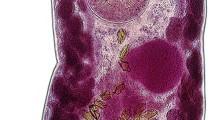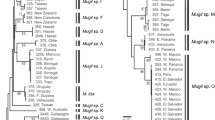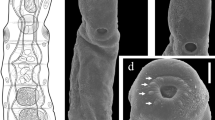Abstract
A single specimen of Uraspis uraspis was collected in the gillnet landings from the coast of Andaman and Nicobar Islands. The present study reports the first geographical record and redescription of Uraspis uraspis from this region. The specimen was identified morphologically and reconfirmed through molecular barcoding. DNA was extracted from the specimen, and the partial region of the cox1 gene was amplified and sequenced. The obtained partial sequence was edited to remove ambiguous nucleotides resulting in a 625 bp long sequence. The sequence was then submitted to the NCBI’s GenBank database (GenBank accession number MZ766929.1). The main distinguishing characteristics of U. uraspis were white tongue, white palate membrane, and naked breast area. Phylogenetic reconstruction of 604 base paired aligned sequence was compared with barcodes of 93 sequences of similar and different species. Upon construction of the maximum likelihood, Neighbor-joining and MrBayes tree, Andaman isolate of Uraspis uraspis species was found to be forming a distinct clade with other species of Uraspis with high statistical support. Analysis of intraspecific and interspecific genetic distance also showed the similarity between Andaman isolate and U. uraspis from other regions (intraspecific genetic distance < 0.01) and the difference between different species of the same genus (interspecific genetic distance > 0.02). Genetic distance values between and within species also supported the distinct clade formation of Uraspis sp. in the phylogenetic trees.








Similar content being viewed by others
Data Availability
The data supporting the findings of this research are available upon request. Please contact corresponding author at (s.venu1974@gmail.com) for inquiries related to data availability and access.
Abbreviations
- CR:
-
Control Region,
- Cyt:
-
Cytochrome region
- DNA:
-
Deoxyribonucleic acid
- COI:
-
Cytochrome oxidase subunit 1
- PCR:
-
Polymerase chain reaction
- Taq:
-
Thermus aquaticus
- dNTP:
-
Deoxynucleotide triphosphate,
- MUSCLE:
-
MUltiple Sequence Comparison by Log Expectation
- MEGA:
-
Molecular Evolutionary Genetics Analysis
- BIC:
-
Bayesian Information Criterion
- GTR + G + I:
-
General time reversible (Gamma distributed, invariant sites)
- DAMBE:
-
Data analysis in molecular biology and evolution
- ML:
-
Maximum likelihood
- NJ:
-
Neighbour Joining
- MEGA:
-
Molecular Evolutionary Genetics Analysis
- BT:
-
Bootstrap
- DnaSP:
-
(Deoxyribonucleic acid Sequence Polymorphism
- MCMC:
-
Markov Chain Monte Carlo
- PP:
-
Posterior probability
- NCBI:
-
National Center for Biotechnology Information
- HL:
-
Head length
- SL:
-
Standard length
- G:
-
Guanine
- T:
-
Thymine
- C:
-
Cytosine
- A:
-
Adenine
- BLAST:
-
Basic Local Alignment Search Tool
- Cox I:
-
Cytochrome c oxidase subunit 1
- K2P:
-
Kimura two-parameter
References
Abdussamad EM, Gopalakrishnan A, Mini KG, Sukumaran S, Divya PR, Retheesh TB, Muhammed AA, Dipti NV, Akhil AR, Thomas T, Jacob KD (2022) Description of a new species of queenfish, Scomberoides pelagicus from Indian seas. J Environ Biol 43(1):105–114.https://doi.org/10.22438/jeb/43/1/MRN-1975
Abdussamad EM, Rohit P, Koya KP, Mohamed OM, Jayabalan K (2013) Carangids (Family: Carangidae) in the seas around Indian subcontinent with description of macro-taxonomic characters for the field identification of genera and species. Indian J Fish 60(2):21–36. http://eprints.cmfri.org.in/id/eprint/9506
Abdussamad EM, Rohit P, Mohamed OMMJ Habeeb (2007) A field identification key for 20 genera of Family Carangidae. J Mar Biol Assoc India 49(2):141–147. http://krishi.icar.gov.in/jspui/handle/123456789/61770
Al-Faisal AJ, Mohamed AR, Jaayid TA (2016) New record of the carangid fish from the Iraqi marine waters, northwest Arabian Gulf.Meso Environ J106–14. https://zoobank.org/64BC7326-F255-40D4-A528-51DAD5A635F4
Babbucci M, Zane L, Andaloro F, Patarnello T (2006) Isolation and characterization of microsatellite loci from yellowtail Seriola dumerilii (Perciformes: Carangidae). Mol Ecol Notes 6(4):1126–1128. https://doi.org/10.1111/j.1471-8286.2006.01459.x
Barik TK, Swain SN, Sahu B, Tripathy B, Acharya UR (2018) Morphological and genetic analyses of the first record of longrakered trevally, Ulua mentalis (Perciformes: Carangidae) and of the pinjalo snapper, Pinjalo pinjalo (Perciformes: Lutjanidae) in the Odisha coast, Bay of Bengal. Mitochondrial DNA Part A 29(4):552–560. https://doi.org/10.1080/24701394.2017.1320993
Barman AS, Singh M, Pandey PK (2018) DNA barcoding and genetic diversity analyses of fishes of Kaladan River of Indo-Myanmar biodiversity hotspot. Mitochondrial DNA Part A29(3):367–378. https://doi.org/10.1080/24701394.2017.1285290
Bektas Y, Belduz AO (2009) Morphological variation among Atlantic horse mackerel, Trachurus trachurus populations from Turkish coastal waters. J Anim Vet Adv 8(3):511–517
Bello G, Causse R, Lipej L, Dulčić J (2014) A proposed best practice approach to overcome unverified and unverifiable “first records” in ichthyology. Cybium 38(1):9–14. https://doi.org/10.26028/cybium/2014-381-002
Bhattacharjee MJ, Laskar BA, Dhar B, Ghosh SK (2012) Identification and re-evaluation of freshwater catfishes through DNA barcoding. PLoS One 7(11):1–7. https://doi.org/10.1371/journal.pone.0049950
Bineesh KK, Gopalakrishnan A, Akhilesh KV, Sajeela KA, Abdussamad EM, Pillai NG, Basheer VS, Jena JK, Ward RD (2017) DNA barcoding reveals species composition of sharks and rays in the Indian commercial fishery. Mitochondrial DNA Part A 28(4):458–472. https://doi.org/10.3109/19401736.2015.1137900
Burridge CP, Smolenski AJ (2004) Molecular phylogeny of the Cheilodactylidae and Latridae with notes on taxonomy and biogeography. Mol Phyl Evol 30:118–127. https://doi.org/10.1016/S1055-7903(03)00157-X
Capapé C, Diatta Y, Diaby A, Rafrafi-Nouira S (2020) First substantiated record of Cotton Mouth jack Uraspis secunda (Carangidae) from the coast of Senegal (E-Atlantic). Thalassia Salentina 42(2020):3–8. https://doi.org/10.1285/i15910725v42p3
Dam Roy S, George G (2010) Marine resources of islands: status and approaches for sustainable exploitation/conservation with special emphasis to Andaman and Nicobar. Indian J Anim Sci 80(4):57–62
Devine BM, Fisher JA (2014) First records of the blue runner Caranx crysos (Perciformes: Carangidae) in Newfoundland waters. J Fish Biol 85(2):540–545. https://doi.org/10.1111/jfb.12438
Edgar RC (2004) MUSCLE: multiple sequence alignment with high accuracy and high throughput. Nucleic Acids Res 32(5):1792–1797. https://doi.org/10.1093/nar/gkh340
Forster JR (1801) In: Bloch & Schneider. M. E. Blochii, Systema Ichthyologiae Iconibus cx Ilustratum. Post obitum auctoris opus inchoatum absolvit, correxit, interpolavit Jo. Gottlob Schneider, Saxo. Berolini. Sumtibus Auctoris Impressum et Bibliopolio Sanderiano Commissum, 1584
Fricke R, Eschmeyer WN, van der Laan, R (2022) Eschmeyer's catalog of fishes: genera, species, references. (http://researcharchive.calacademy.org/research/ichthyology/catalog/fishcatmain.asp). Electronic version accessed 30 Jan 2022.
Gibinkumar TR, Sabu S, Pravin P, Boopendranath MR (2012) Bycatch characterization of shrimp trawl landings off Southwest Coast of India. Fish Technol 49:132– 140.http://krishi.icar.gov.in/jspui/handle/123456789/51528
Golding GB, Hanner R, Hebert PD (2009) Preface. Special issue on DNA barcoding. Mol Ecol Resour 9:4–6. https://doi.org/10.1111/j.1755-0998.2009.02654.x
Guimarães-Costa AJ, Machado FS, Oliveira RR, Silva-Costa V, Andrade MC, Giarrizzo T, Saint-Paul U, Sampaio I, Schneider H (2019) Fish diversity of the largest deltaic formation in the Americas-a description of the fish fauna of the Parnaíba Delta using DNA Barcoding. Sci Rep 9(1):1–8. https://doi.org/10.1038/s41598-019-43930-z
Gunn JS (1990) A revision of selected genera of the family Carangidae (Pisces) from Australian waters. Rec Aust Mus 12:1–20. https://doi.org/10.3853/j.0812-7387.12.1990.92
Günther A (1860) Catalogue of the fishes in the British Museum. Catalogue of the acanthopterygian fishes in the collection of the British Museum. Squamipinnes, Cirrhitidae, Triglidae, Trachinidae, Sciaenidae, Polynemidae, Sphyraenidae, Trichiuridae, Scombridae, Carangidae, Xiphiidae. Brit Mus, London, v. 2: ixxi+1548
Gurlek M, Erguden D, Dogdu SA, Turan C (2016) First record of greenback horse mackerel, Trachurus declivis (Jenyns, 1841) in the Mediterranean Sea. J Appl Ichthyol 32(5):976–977. https://doi.org/10.1111/jai.13159
Hall T (1999) BioEdit: a user-friendly biological sequence alignment editor and analysis program for Windows 95/98/NT. In Nucleic Acids Symp Ser 41:95–98
Hebert PD, Ratnasingham S, De Waard JR (2003) Barcoding animal life: cytochrome c oxidase subunit 1 divergences among closely related species. Proc Royal Soc Lond Ser B: Biol Sci 270(1):96–99. https://doi.org/10.1098/rsbl.2003.0025
Honebrink RR (2000) A review of the biology of the family Carangidae, with emphasis on species found in Hawaiian waters. Division of Aquatic Resources Technical Report, 20–01, 43 pp
Joshi KK, Sreeram MP, Zacharia PU, Abdussamad EM, Varghese M, Habeeb Mohammed OM, Jayabalan K, Kanthan KP, Kannan K, Sreekumar KM, George G (2016) Checklist of fishes of the Gulf of Mannar ecosystem, Tamil Nadu, India. J Mar Biol Assoc India 58(1):34–54. https://doi.org/10.6024/jmbai.2016.58.1.1895-05
Joshi KK, Nair RJ, Samad EM, Thomas S, Kakati VS, Jasmine S, Varghese M, Miriam Paul S, Sukumaran S, George RM, Manisseri MK (2011)The Carangids of India: A Monograph. Central Marine Fisheries Research Institute, Indian Council of Agricultural Research. https://www.nhbs.com/the-carangids-of-india-book
Kimura M (1980) A simple method for estimating evolutionary rate of base substitutions through comparative studies of nucleotide sequences. J Mol Evol 16:111–120. https://doi.org/10.1007/BF01731581
Kumar S, Stecher G, Li M, Knyaz C, Tamura K (2018) MEGA X: molecular evolutionary genetics analysis across computing platforms. Mol Biol Evol 35(6):1547. https://doi.org/10.1093/molbev/msy096
Lakra WS, Verma MS, Goswami M, Lal KK, Mohindra V, Punia P, Gopalakrishnan A, Singh KV, Ward RD, Hebert P (2011) DNA barcoding Indian marine fishes. Mol Ecol Resour 11(1):60–71. https://doi.org/10.1111/j.1755-0998.2010.02894.x
Laskar BA, Bhattacharjee MJ, Dhar B, Mahadani P, Kundu S, Ghosh SK (2013) The species dilemma of northeast Indian mahseer (Actinopterygii: Cyprinidae): DNA barcoding in clarifying the riddle. PLoS ONE 8(1). https://doi.org/10.1371/journal.pone.0053704
Legalle M, Mastrorillo S, Céréghino R (2008) Spatial distribution patterns and causes of decline of three freshwater species with different biological traits (white-clawed crayfish, bullhead, freshwater pearl mussel): a review. In Annales De Limnologie-International Journal of Limnology, EDP Sciences 44(2):95–104. https://doi.org/10.1051/limn:2008018
Lin PL, Shao KT (1999) A review of the carangid fishes (Family Carangidae) from Taiwan with descriptions of four new records. Zool Stud 38(1):33–68
Ma CY, Ma HY, Ni Y, Wang W, Ma LB (2015) Molecular identification of the genus Thryssa based on DNA barcoding. Genet Mol Res 14(4):18580–18586. https://doi.org/10.4238/2015.December.28.5
Ma H, Ma C, Zhang X, Feng C, Zhang Y, Zhang H, Ma L (2017) The first complete mitochondrial genome sequence of Uraspis secunda (Perciformes: Carangidae) and its phylogenetic relationship. Mitochondrial DNA Part A 28(1):87–88. https://doi.org/10.3109/19401736.2015.1110811
Masuda H, Amaoka K, Araga C, Uyeno T, Yoshino T (1984) The fishes of the Japanese Archipelago 1:437
Mat Jaafar TN, Taylor MI, Mohd Nor SA, de Bruyn M, Carvalho GR (2012) DNA barcoding reveals cryptic diversity within commercially exploited Indo-Malay Carangidae (Teleosteii: Perciformes). PLoS ONE 7(11). https://doi.org/10.1371/journal.pone.0049623
Miller S A, Dykes D D, Polesky H F (1988) A simple salting out procedure for extracting DNA from human nucleated cells. Nucleic Acids Res 16(3):1215. https://doi.org/10.1093/nar/16.3.1215
Mohamad Kasim H (2003) Carangids. In: Joseph MM, Jayaprakash AA (eds) Status of Exploited Marine F9ishery Resources of India. Central Marine Fisheries Institute, Cochin, India, 66–75 pp
Mohamed AR, Al-Faisal AJ, Jaayid TA (2017) Occurrence of carangid fish Uraspis helvola (Forster, 1801) from the Iraqi marine waters, Arabian Gulf. Asian J Appl Sci 5(2):337–342
Mukherjee M, Karna SK, Suresh VR, Manna RK, Panda D, Apurba RA (2018) New records of Carangids (Perciformes: Carangidae) from Chilika Lagoon, east coast of India. FishTaxa 2(4):226–231. https://www.biotaxa.org/ft/article/view/2-4-5
Nair PN (2000) Carangid resources of India. In: Pillai VN, Menon NG (eds) Marine fisheries Research management. Central Marine Fisheries Institute, Cochin, India, pp 317–348
Nair RJ, Joshi KK, Kuriakose S, Geetha PM (2010) Study on the Diversity of Carangid Resources off Cochin, Kerala. In: Coastal Fishery Resources of India - Conservation and sustainable utilisation. Society of Fisheries Technologists, 98–108 pp
Nelson JS (2006) Fishes of the World, 4th edn. John Wiley and Sons, New York, p 601
Patankar V, Paranjape A, Tyabji Z, Wagh T, Marathe A (2018) Occurrence and distribution of tetraodontiform fishes of the Andaman and Nicobar Islands. India Check List 14(3):529–537. https://doi.org/10.15560/14.3.527
Persis M, Chandra Sekhar Reddy A, Rao LM, Khedkar GD, Ravinder K, Nasruddin K (2009) COI (cytochrome oxidase-I) sequence based studies of Carangid fishes from Kakinada coast, India. Mol Biol Rep 36(7):1733–1740. https://doi.org/10.1007/s11033-008-9375-4
Poey F (1860) Memorias sobra la historia natural de la Isla de Cuba, occurrenceacompañadas de sumarios Latinos y extractos en Francés. Tomo 2. La Habana, v. 2:223
Rajan PT, Sreeraj CR (2013) Fish fauna of andaman and nicobar islands: a review. In: Venkataraman, K., Sivaperuman, C., Raghunathan, C. (eds) Ecology and Conservation of Tropical Marine Faunal Communities. Springer, Berlin, Heidelberg. https://doi.org/10.1007/978-3-642-38200-0_15
Rajan PT, Mishra SS (2018) Fishes of Andaman and Nicobar Islands–an updated checklist. J Andaman Sci Assoc 23(2):148–181
Rambaut A (2016) FigTree v1.4.3. http://tree.bio.ed.ac.uk/software/figtree/
Randall JE, Allen GR, Steene RC (1998) The complete diver's and fisherman's guide to fishes of the Great Barrier Reef and Coral Sea. Crawford House Press, Bathurst, Australia
Ranjan Kumar R, Venu S, Akhilesh KV, Bineesh KK (2018) First report of four deep-sea chondrichthyans (Elasmobranchii and Holocephali) from Andaman waters, India with an updated checklist from the region. Acta Ichthyol Piscat 48(3):289–301. https://doi.org/10.3750/AIEP/02336
Ribeiro AD, Caires RA, Mariguela TC, Pereira LH, Hanner R, Oliveira C (2012) DNA barcodes identify marine fishes of São Paulo State, Brazil. Mol Ecol Resour 12(6):1012–1020. https://doi.org/10.1111/1755-0998.12007
Ronquist F, Teslenko M, Van Der Mark P, Ayres DL, Darling A, Höhna S, Larget B, Liu L, Suchard MA, Huelsenbeck JP (2012) MrBayes 3.2: efficient Bayesian phylogenetic inference and model choice across a large model space. Syst Biol 61(3):539–542. https://doi.org/10.1093/sysbio/sys029
Rozas J, Ferrer-Mata A, Sánchez-DelBarrio JC, Guirao-Rico S, Librado P, Ramos-Onsins SE, Sánchez-Gracia A (2017) DnaSP 6: DNA sequence polymorphism analysis of large data sets. Mol Biol Evol 34(12):3299–3302. https://doi.org/10.1093/molbev/msx248
Saha T, Datta SK, Zhilik AA, Chowdhury NZ, Baki MA, Ahmed MS (2021) New Geographical Record of the Rainbow Runner, Elagatis bipinnulata (Quoy & Gaimard, 1825) (Perciformes: Carangidae) from the Bay of Bengal, Bangladesh.Thalassas Int J Mar Sci 37(1):23–26. https://doi.org/10.1007/s41208-020-00264-2
Saha A, Subhedar N (2011) Calcitonin-like immunoreactivity in the subcommissural organ–Reissner's fiber complex of some freshwater and marine teleosts. J Chem Neuroanat 41(2):122–128. https://doi.org/10.1016/j.jchemneu.2010.12.00
Senou H (2013) Carangidae. In: Nakabo T (ed) Fishes of Japan with pictorial keys to the species, 3rd edn. Tokai Univ. Press, Tokyo, pp 878–899
Sivakami S (1996) On the food habits of the fishes of the family Carangidae a review. J Mar Biol Assoc India 38(1 & 2):118–123
Smith-Vaniz WF (1986) Family No. 210: Carangidae. In: Smith MM, Heemstra PC (eds) Smith’s Sea fishes. Springer-Verlag, Grahamstown, pp 209–661
Smith-Vaniz WF (1999) Carangidae. Jacks and scads (also trevallies, queenfishes, runners, amberjacks, pilot- fishes, pampanos, etc.). pp. 2659–2756. In: Carpenter KE, Niem VH (eds), FAO species identifica- tion guide for fishery purposes. The living marine resources of the Western Central Pacific. Vol. 4. Bony fishes, part 2 (Mugilidae to Carangidae). Rome, FAO, 2069–2790
Smith-Vaniz WF (2002) Carangidae. In: Carpenter K (ed) The living marine resources of the Western Central Atlantic. Vol. 3: Bony fishes, part 2 (Opistognathidae to Molidae, Sea turtles and marine mammals, pp 1426–1460. FAO: Rome
Swart BL, von der Heyden S, Bester-van der Merwe A, Roodt-Wilding R (2015) Molecular systematics and biogeography of the circumglobally distributed genus Seriola (Pisces: Carangidae). Mol Phylogenet Evol 93:274–280
Trivedi S, Affan R, Alessa AH, Ansari AA, Dhar B, Mahadani P, Ghosh SK (2014) DNA barcoding of Red Sea fishes from Saudi Arabia–the first approach. DNA Barcodes 2(1):17–20. https://doi.org/10.2478/dna-2014-0003
Ward RD, Zemlak TS, Innes BH, Last PR, Hebert PD (2005) DNA barcoding Australia's fish species. Philos Trans R Soc BBiol Sci 360(1462):1847–1857. https://doi.org/10.1098/rstb.2005.1716
Willette DA, Padin JI (2014) Identifying the biodiversity of marine jacks (Carangidae) in the freshwater Taal Lake, Philippines using phenotypic features and mitochondrial DNA. J Appl Ichthyol 30(3):490–495
Williams F (1961) On Uraspis Wakiyai sp. nov. (Pisces, Carangidae) from the Western Indian Ocean, with a review of the species of Uraspis Bleeker, 1855, ss.Ann Mag Nat Hist4(38):65–87
Xia X (2018) DAMBE7: New and improved tools for data analysis in molecular biology and evolution. Mol Biol Evol 35(6):1550–1552. https://doi.org/10.1093/molbev/msy073
Yancy HF, Zemlak TS, Mason JA, Washington JD, Tenge BJ, Nguyen NL, Barnett JD, Savary WE, Hill WE, Moore MM, Fry FS (2008) Potential use of DNA barcodes in regulatory science: applications of the Regulatory Fish Encyclopedia. J Food Prot 71(1):210–217. https://doi.org/10.4315/0362-028X-71.1.210
Yeo S, Kim JK (2016) New record of Uraspis uraspis and redescription of Uraspis helvola (Pisces: Carangidae) from Korea. Korean J Ichthyol 28(1):57–64
Zhang Z, Schwartz S, Wagner L, Miller W (2000) A greedy algorithm for aligning DNA sequences. J Comput Biol 7(1–2):203–214. https://doi.org/10.1089/10665270050081478
Acknowledgements
The authors thank Pondicherry University for providing the necessary facilities and financial assistance to carry out this research
Funding
UGC Non-NET Fellowship. All data are available in the manuscript.
Author information
Authors and Affiliations
Contributions
Sample collection & manuscript writing – Ramees, M. P. V., Venu S., & Ameen, U., Morphometric measurements & data analysis – Ramees, M. P. V., Parveen, F. P. S. & Samrat, K. Sample Identification – Ramees, M. P. V., Ameen, U., Parveen, F. P. S. and Samrat, K1. Barcode study– Ramees, M. P. V., Kashyap, K., & Ameen, U. Manuscript concept – Ramees, M. P. V., Kashyap, K., Venu S., All authors read, incorporated, and approved the manuscript.
Corresponding author
Ethics declarations
Ethical Approval
No animal testing was performed during this study.
Competing Interests
The authors declare no competing interests.
Additional information
Publisher's Note
Springer Nature remains neutral with regard to jurisdictional claims in published maps and institutional affiliations.
Supplementary Information
Below is the link to the electronic supplementary material.
Rights and permissions
Springer Nature or its licensor (e.g. a society or other partner) holds exclusive rights to this article under a publishing agreement with the author(s) or other rightsholder(s); author self-archiving of the accepted manuscript version of this article is solely governed by the terms of such publishing agreement and applicable law.
About this article
Cite this article
Ramees, P.V.M., Kashyap, K., Venu, S. et al. First Geographical Record and Re-description of White Mouth Jack Uraspis Uraspis (Günther, 1860) From Andaman and Nicobar Islands With a Detailed Phylogenetic Analysis Based Validation for the Morphological Identification. Thalassas 40, 237–248 (2024). https://doi.org/10.1007/s41208-023-00633-7
Received:
Revised:
Accepted:
Published:
Issue Date:
DOI: https://doi.org/10.1007/s41208-023-00633-7




